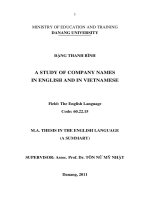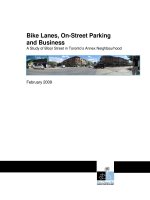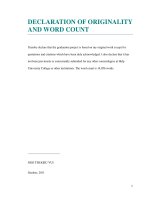Internal market orientation, frontliners’ organizational commitment and customer-oriented behavior: A study of airport service in Vietnam - TRƯỜNG CÁN BỘ QUẢN LÝ GIÁO DỤC THÀNH PHỐ HỒ CHÍ MINH
Bạn đang xem bản rút gọn của tài liệu. Xem và tải ngay bản đầy đủ của tài liệu tại đây (508.33 KB, 7 trang )
<span class='text_page_counter'>(1)</span><div class='page_container' data-page=1>
Nguyen Thi Hong Phuong et al. Journal of Science Ho Chi Minh City Open University, 8(3), 132-145 132
<b>Internal market orientation, frontliners’ organizational </b>
<b>commitment and customer-oriented behavior: </b>
<b>A study of airport service in Vietnam </b>
Nguyen Thi Hong Phuong1<sub>, Le Nguyen Hau</sub>2*<sub>, Tran Thi Tuyet</sub>2<sub>, Nguyen Van Tuan</sub>2
1<sub>Lien Khuong Airport - Lam Dong </sub>
2<sub>Ho Chi Minh City University of Technology, Vietnam National University HCMC, </sub>
Vietnam
*<sub>Corresponding author: </sub>
<b>ARTICLE INFO </b> <b>ABSTRACT </b>
<b>DOI:</b>10.46223/HCMCOUJS.
econ.en.8.2.167.2018
Received: May 17th<sub>, 2018 </sub>
Revised: August 19th<sub>, 2018 </sub>
Accepted: September 16th<sub>, 2018 </sub>
<i>Keywords:</i>
airport service,
customer-oriented behavior, internal
market orientation,
organizational commitment
This research examines the three-component structure of
the concept internal market orientation (IMO) and investigates
its impact on frontliners’ organizational commitment (OC) and
customer-oriented behavior (COB) in the context of airport
service in Vietnam. Based on a sample of 294 frontliners
working in various airports, SEM analysis reveals that IMO has
a strong impact on OC. It also has direct and indirect impacts on
COB. Moreover, the empirical result supports the component
structure of IMO. It is, therefore, suggested that IMO is
powerful to enhance both internal employee management and
external marketing performance in the research context.
<b>1. Introduction </b>
The aviation service in Vietnam has been developing enormously during recent years.
According to the International Air Transport Association (IATA, 2016), Vietnam will be among
the five fastest-growing markets in terms of additional passengers per year over the 2015-2035
period. However, besides this positive signal for the market, this fast growth entails a number
of challenges for service providers in the field. One of the inevitable problems is the work-load
of ground-service employees at airports which negatively affect their attitude and behavior at
work. This situation calls for managerial attention to ensure a highly committed workforce and
good services being offered to passengers.
</div>
<span class='text_page_counter'>(2)</span><div class='page_container' data-page=2>
133 Nguyen Thi Hong Phuong et al. Journal of Science Ho Chi Minh City Open University, 8(3), 132-145
attitudes and behaviors have received much attention from several researchers recently (e.g.,
Buil, Martínez, & Matute, 2016; Plouffe, Bolander, Cote, & Hochstein, 2016; Stock, Jong, &
Zacharias, 2017).
Literature has established that there are generally two categories of factors affecting
employees’ attitudes and behavior, namely organizational factors and dispositional factors
(Schneider & Smith, 2004). Within the managerial perspective, the current study focuses on
exploring organizational measures to foster service frontliner’s favorable behaviors of an
organization’s existing workforce. Among organizational measures, internal marketing has
received attention from researchers and practitioners as an effective way to influence
employees. Basically, internal marketing is a management philosophy viewing employees as
customers of the firm (Lings & Greenley, 2009). It promotes the idea that satisfying the wants
and needs of service employees, especially frontliners, is a prerequisite to their job commitment
and also ensures a good service to customers (Lings, 2004). In other words, the implementation
of internal marketing in a firm, which is termed internal market orientation - IMO (Lings, 2004;
Yu, Yen, Barnes, & Huang, 2017) is a promising measure to satisfy both (internal) employees
and (external) customers.
Accordingly, IMO is defined as internal information generation and dissemination in
order to facilitate organizational favorable responses to satisfy employees’ wants and needs
(Lings, 2004). As such, it is essential that IMO facilitates favorable attitudes and behaviors of
frontliners towards the firm as well as its customers. Literature has shown a number of studies
to validate such role of IMO (e.g., Bae, Kim, & Kim, 2017; Gounaris, 2006; Lings & Greenley,
2005; Yu et al., 2017). However, the majority of these studies were conducted in developed
countries. Empirical studies in emerging and Confucius countries like Vietnam have still been
limited. Moreover, empirical studies specifically undertaken in airport service are scant.
Therefore, an empirical study in Vietnam airport service is needed to revalidate the theory of
IMO which was originated in the West. Moreover, given the airport situation in Vietnam being
described above, it is necessary to answer the question if IMO is a potential solution to the
aforesaid problem.
Against the above analysis, the current research is formulated with a threefold objective.
First, it identifies the component structure of IMO in the specific context of airport service firms
in Vietnam. Secondly, it investigates the impact of IMO on frontliner’s organizational
commitment (OC). Thirdly, it accesses the total (direct and indirect) effect of IMO on
frontliner’s customer-oriented behavior (COB). Here, OC is selected as a representation of a
high quality relationship between an employee and the firm (Meyer, Stanley, Herscovitch, &
Topolnytsky, 2002). Similarly, COB is a proxy construct of employee marketing performance
towards external customers (Kelley, 1992).
</div>
<span class='text_page_counter'>(3)</span><div class='page_container' data-page=3>
Nguyen Thi Hong Phuong et al. Journal of Science Ho Chi Minh City Open University, 8(3), 132-145 134
<b>2. Theoretical background and hypotheses </b>
<b>Employee’s Customer-Oriented Behavior (COB) </b>
In a broad view, the construct of customer orientation can be approached from
firm-level view or individual-firm-level view. At the firm firm-level, it is conceptualized as a set of
organizational beliefs that puts the customer’s interests first, besides those of other stakeholders
in order to develop a long-term profitable company (Hartline, Maxham, & McKee, 2000). At
the individual level, customer orientation is defined as the willingness of individual service
employees to customize the service delivery in accordance with customer’s situations such as
needs, problems, special circumstances (Daniel & Darby, 1997). The current study approaches
the construct from the individual level perspective which focuses on the customer- oriented
behavior (COB). Particularly, COB refers to specific behaviors displayed by service frontliners
during service encounters to fulfill customer-specific needs in relation to specific problems and
circumstances (Winsted, 2000).
Winsted (2000) suggests that COB is a three-dimensional construct which is common
in both western and eastern culture, including (1) <i>Concern </i>combining elements of empathy,
assurance, responsiveness, authenticity as well as perceived competence, listening and
dedication. (2) <i>Civility </i>including a variety of behaviors service personnel should express to
customers. These behaviors basically relate the employees’ attitude, courtesy and attention. (3)
<i>Congeniality </i>relating to the frontline staff’s positive attitudes, sunny temperament and warm
personality.
<b>Internal Market Orientation (IMO) </b>
IMO is based on the philosophy of treating frontline employees as customers of the firm
(Lings, 2004). Therefore, IMO encourages organizations to build effective relationships with
employees through the commitment to producing value for its internal market (employees)
much in the same way as the commitment is required to provide value for its external customers
(Gounaris, 2006). Moreover, it suggests that satisfied, motivated and committed frontline
employees are crucial if customers are to receive good service (Lings, 2004). To operationalize
the construct, several studies have modeled IMO as a second-order reflective construct
consisting of three components (Gounaris, 2006; Lings & Greenley, 2005), namely:
<i>Generating information </i>pertinent to the internal market: regarding the collection of
information about important attributes of jobs, the satisfaction of employees with their working
conditions, internal and external factors that influence employee satisfaction, the external
market, e.g., legislative changes, activities of competitors in the employee market and
employment conditions with firms competing for the same employees.
<i>Communication of information </i> pertinent to the internal market: regarding the
</div>
<span class='text_page_counter'>(4)</span><div class='page_container' data-page=4>
135 Nguyen Thi Hong Phuong et al. Journal of Science Ho Chi Minh City Open University, 8(3), 132-145
<i>Responding to information (or responsiveness) </i>pertinent to the internal market:
regarding designing jobs, adjusting remuneration schemes, offering training and showing
management consideration with regard to the employees’ feedback on their needs.
<b>Organizational Commitment (OC) </b>
Organizational commitment refers to the emotional attachment which employees form
with the organization, based on shared values and interests (Meyer & Allen, 1997). Meyer and
Allen (1991) suggest that employees remain with the organization because they are effectively
attached (wants to), they are continually attached (need to) or they are normatively attached
(ought to). According to Meyer and Allen (1991), employees who want to belong with the
organization are more willing to exert effort on behalf of the organization than those who need
to or ought to do so. Therefore, for simplicity, this study will investigate the affective dimension
(want to) of the construct of employees’ organizational commitment.
<b>Foundational background: Theory of social exchange </b>
The reasoning of the relationship between IMO and employees’ attitudes and behaviors
is grounded in the theory of social exchange (Emerson, 1976), which is based on an obligation
to reciprocate (Cropanzano & Mitchell, 2005). Accordingly, the social exchange theory implies
that employees will display favorable attitudes and behaviors toward the organization as a way
to show their appreciation to their employer for creating satisfactory working conditions. Allen
and Shanock (2013) suggested that if firms are considered as being deeply concerned about
their employees’ interests, staff members tend to show more positive attitudes and behaviors to
the organization. As a result, the current research argues that employees’ perception of an
enhanced level of IMO will lead them to be more committed to the organization and being more
customer-oriented on delivering service to customers.
<b>Proposed hypotheses </b>
In this study, the unit of analysis is a frontline employee. Thus, IMO is investigated in
the view of frontline employees’ perceptions and proposed to enhance their attitudes and job
behaviors.
</div>
<span class='text_page_counter'>(5)</span><div class='page_container' data-page=5>
Nguyen Thi Hong Phuong et al. Journal of Science Ho Chi Minh City Open University, 8(3), 132-145 136
<i>H1: Internal market orientation has a positive relationship with airport frontliners’ </i>
<i>organizational commitment. </i>
<b>IMO and COB: </b>The adoption of IMO may encourage employees to enact firms’
marketing strategies and incorporate this into their normal in-role behaviors in their day-to- day
work. Therefore, focusing on employees’ wants and needs impacts their behaviors toward the
market. That is, IMO plays an important role in enhancing the good relationship between
employees and customers, which leads to ensuring service quality, customers’ satisfaction and
financial performance (Lings & Greenley, 2005). As mentioned before, the rationale is implied
in the concept of exchange between employees and the organization in which employees
evaluate the jobs by comparing the inputs (time, effort, loyalty, etc.) and the outputs (pay,
benefits, recognition, status, etc.). Behaviors of managers concerning rewards employees
should receive have an impact on employee’s behaviors and attitudes and organizational
effectiveness (Freedman & Montanari, 1980; Guest & Conway, 2002). Meanwhile, IMO aims
to create a balance between employees’ perceptions of what they put into their job and their
perceptions of what they get out of the job (Lings & Greenley, 2005). Applying this general
analysis to this research context of airport service, it is argued that IMO encourages employees
to behave in a customer-oriented manner. Therefore, the hypothesis states as follow
<i>H2: Internal market orientation has a positive relationship with airport frontliners’ </i>
<i>customer-oriented behaviors. </i>
<b>OC and COB: </b>Several researchers have suggested that organizational commitment has
impacts on employees’ behaviors and performance (Finegan, 2000; Meyer, Allen, & Smith,
1993). That is, a committed employee is willing to exert considerable and sustained personal
effort to meet organizational goals, comply with organizational values (Bansal, Mendelson, &
Sharma, 2001) and to satisfy customer (Lanjananda & Patterson, 2009). Applying this notion
to the case of frontliners in airports, their main missions are to undertake the service process in
interaction with customers and to serve them to the satisfactory level. Referring to the above-
mentioned literature review, their efforts to satisfy customers is reflected in their COB.
Therefore, it is argued in this study of airport service that when a frontline employee is
committed to the organization, she is more willing to work in a customer-centric manner when
delivering the service on behalf of the organization. Therefore, it is hypothesized:
<i>H3: Organizational commitment has a positive relationship with airport frontliners’ </i>
<i>customer-oriented behaviors. </i>
</div>
<span class='text_page_counter'>(6)</span><div class='page_container' data-page=6>
137 Nguyen Thi Hong Phuong et al. Journal of Science Ho Chi Minh City Open University, 8(3), 132-145
<b>3. Method </b>
The research setting is the airport service in Vietnam. As mentioned in the beginning,
in the past decade, together with the development of Vietnam’s economy, the number of
passengers using domestic airports has risen at a fast speed. This makes the aviation market in
Vietnam is among the five most fast-growing markets in the world (IATA, 2016). As a result,
frontliners are often busy taking good care of all passengers. Moreover, the long-standing
“asking - giving” practice in which public service providers think that they are giving service
to passengers, not serving passengers still exists to a certain extent. As a result, frontliners in
domestic airports are supposed to display COB to a varying degree during service encounters.
In this setting, customer-contact employees consist of airport service staff who provide
passengers with a variety of tasks including parking and baggage help, information help,
check-in and screencheck-ing staff, security check. Accordcheck-ingly, the proposed model and hypotheses were
tested using survey data obtained from frontline employees at three airports in Vietnam namely,
Lien Khuong (Lam Dong); Phu Bai (Hue); Cam Ranh (Khanh Hoa). These airports were
selected conveniently based on their willingness to participate in the survey. Additionally, in
the mentioned airports, all tasks of ground services offered to passengers are provided by
frontline employees of one organization, while in big airports like Tan Son Nhat or Noi Bai,
some of the tasks or services are carried out by staff from different organizations, including
airline staff.
The sample comprised 294 cases surveyed from frontline airport staff. Data were
obtained by means of a structured questionnaire directly delivered and collected at these airports
by a survey team of trained people, and were led by one of the authors who is the director of one
of the airports. A convenience sampling technique was employed.
In terms of measurement scale (see Table 2), three reflective components of internal
market orientation (IMO) namely Information Generation (5 items), Information Dissemination
(4 items), Responsiveness (4 items) were measured by total 13 reflective items adopted from
Lings and Greenley (2005). Employee Organizational Commitment (OC) was measured by 4
reflective items adopted from Meyer and Allen (1991). Employee’s COB was measured by 5
items borrowing from Pimpakorn and Patterson (2010). The scale items were translated into
Vietnamese language and checked carefully by two bilingual university faculties. All scales
were in the form of Likert type anchoring from 1 (totally disagree) to 5 (totally agree).
<b>Results and discussion </b>
</div>
<span class='text_page_counter'>(7)</span><div class='page_container' data-page=7>
Nguyen Thi Hong Phuong et al. Journal of Science Ho Chi Minh City Open University, 8(3), 132-145 138
<b>Table 1 </b>
Sample characteristics (N=294)
<b>Variable </b> <b>Frequency </b> <b>% </b> <b> Variable </b> <b>Frequency % </b>
Gender: Education:
Male 168 57.1 High school/College 54 18.4
Female 126 42.9 University or higher 240 81.6
Work Experience: Age group:
Under 2 years 66 22.4 30 or under 132 44.9
2 – under 4 yrs 92 31.3 31- 40 124 42.2
4 – under 8 yrs 40 13.6 41 or more 38 12.9
8 – under 15 yrs 66 22.4
15 yrs or more 30 10.2
Source: The researcher’s data analysis
<b>Validity and reliability of measures </b>
Firstly, an exploratory factor analysis (EFA) was applied to all scales together for a
preliminary assessment of scales. The result indicated that the factor structure fully matched the
design and each item loaded mainly on its designated factor. Next, the 22 items measuring five
first-order constructs were submitted to confirmatory factor analysis (CFA) using AMOS
software (Arbuckle & Wothke, 1999) to assess the measurement model. The kurtosis values of
all variables were within -0.46 to +1.97 and skewness values ranged from -1.10 to -0.14.
Although the data exhibited slight deviations from a normal distribution, it was appropriate for
maximum likelihood (ML) estimation to be applied (Kline, 2015).
<b>Table 2 </b>
Scale items and standardized loadings
<b> Item key words </b> <b>Std. </b>
<b>loadings </b>
<b>Information Generation </b>(CR=0.79; AVE=0.55)
The airport surveys employees to access our perceived quality of employment.
Management meet with employees to find out their expectations
Management interacts directly with employees to find out ways to satisfy them.
Management finds out employees’ true feelings in daily conversations.
When any employee acts differently, management will find out if there is a problem.
</div>
<!--links-->









